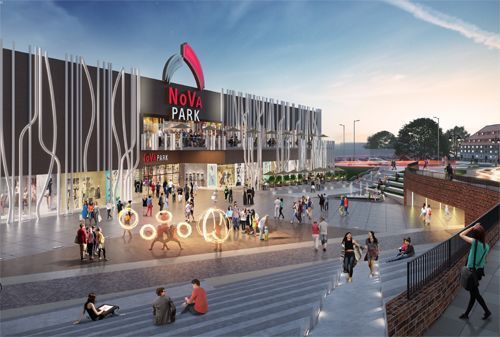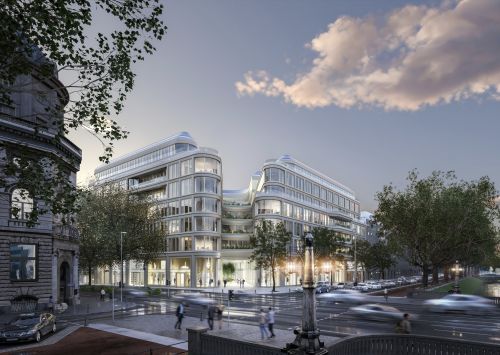Onwards and outwards
Retail & leisure
After a quarter of a century of development, the Polish retail market now totals more than 13.5 mln sqm. The early days were the easiest: a hypermarket was enough for consumers to turn up in droves to do their shopping. As time went by, new generations and types of retail buildings emerged and plots in smaller and smaller towns have been filled up. Poland has now caught up with Western Europe and, according to the Polish Council of Shopping Centres, the retail space saturation is nearing 300 sqm per 1,000 inhabitants across the country. If you factor in the development of online retail, we now have a picture of a market that has become ever more competitive, while the battle for customers has become increasingly fierce. So the best approach now is to attract shoppers with a new design or an improved and extended range of brands.
Downhill
Extensions and modernisations themselves are not a new phenomenon, but they recently peaked in 2015. Every third square metre completed last year was created in this way. But the forecasts for this year and the next are for fewer redevelopments and extensions. “In 2015 this amounted to 30 pct of the supply and we estimate that this year the figure will come to 22 pct, while in 2017 it will fall back to about 15 pct. In spite of the declining trend, it will still be a very significant phenomenon on the market. Nearly half of the space in shopping centres in Poland is more than ten years old. Redevelopments and extensions – as long as they are economically justified – are a natural trend,” believes Renata Kusznierska, a partner and director of the retail department at Cushman & Wakefield in Poland.
The owners of retail centres seem to be working along these lines and extending not only established buildings on the largest markets, such as Galaxy and the Ster shopping centre in Szczecin, Atrium Promenada and Centrum Janki in Warsaw, Port Łódź, Galeria Krakowska and Poznań City Centre, but also smaller centres in small local markets, such as Era Park in Radomsko, Galeria Łysica in Ostrowiec Świętokrzyski and Galeria Mrówka in Ciechanów. According to C&W, another important trend has also emerged – the extension and improvement of the retail in shopping arcades attached to hypermarkets. This approach has been gradually implemented by the Carrefour chain (Morena Gdańsk, Zielone Wzgórza in Białystok and Galeria Gryf in Szczecin) as well as Immochan in shopping centres including or next to Auchan stores (recently in Gdańsk and Białystok).
Older centres usually have one basic asset – a good location – and this is attractive to investors. “We want to buy older shopping centres in good locations and revitalise them,” reveals Marcin Materny, the member of the board at Echo Investment responsible for the retail segment. Futureal is is one investor sniffing around for new purchases, while also preparing for the extension of the Nova Park shopping centre in Gorzów Wielkopolski. By 2020 an additional retail area is to be added to the mall. In Poznań the retail development market is currently based on extensions and redevelopments, while Kraków has also seen a spate of modernisations, extensions and remodellings of existing shopping centres. The greatest change will come in the next few years with the opening of the Serenada shopping centre, which will be integrated with the existing Krokus mall to become one of the largest centres in the city. It is also worth pointing out the planned changes to the function of Galeria Plaza, which is to be transformed into an outlet centre,” says Katarzyna Michnikowska, a senior analyst in the consultancy and market research department at Colliers International.
The effect is what counts
The number of reasons for decisions to enlarge and modernise probably equals the number of centres themselves. However, there are a few main factors worth mentioning. “Owners are deciding to refurbish or extend malls because they want to make successful centres bigger. Such a decision is often prompted by the presence of a new mall. We have also recently seen situations where the owner of an existing shopping centre extends it in order to make it more difficult for their competition to enter the market. It could also be the case that the quality of some centres does not fit in with the current reality and so in order to keep your customers, they need to be modernised,” explains Renata Kusznierska.
This was the conclusion reached by the owner of ETC Swarzędz, who has opted for modernisation. “The ETC project has a great deal of potential. It has over 20 years of retail tradition, it is popular with the residents of Swarzędz and has taken root in their consciousness. However, due to the fact that it was built in the 1990s, it no longer corresponds visually or functionally to the needs of modern consumers and tenants. The goal we have set ourselves is to restore it to its former glory and adapt it to the current market trends,” claims Stefan Ausch, a managing partner at Arkon Group.
An extension is also an opportunity to change the character of a retail centre. “By introducing the ‘destination points’ concept, we want to create unique shopping places, in which the positive experience of customers surpasses that of the shopping itself. We want to give them a range of entertainment and a place to relax so they can enjoy their visit while doing their shopping or meeting business clients. This strategic goal will involve investing in the development of our centres in the most dynamically developing regions. The Atrium Promenada centre in Warsaw, our flagship project, is an ideal example of our concept for a shopping centre worthy of the 21st century,” declares Jolanta Wawrzyszuk, the operations director at Atrium Poland Real Estate Management.
Even the most prominent centres on the market are not going to be free from changes. Such Warsaw malls as Arkadia and Galeria Mokotów have to follow the trend. The Designer Gallery is to be launched over an area of more than 3,100 sqm in Galeria Mokotów this November. This is to be located on the first floor and has been designed as a new section that will not be exclusively for shopping. Investment costs for the redevelopment are estimated at PLN 10 mln. Unibail-Rodamco will also be extending Arkadia by 2,000 sqm. This involves moving the main façade forwards towards the Radosława roundabout, providing additional space on the first floor for the introduction of its Dining Plaza concept.
It helps to talk
However, you need to prepare well for such changes. Consultations with tenants and communication with the customers are particularly important. A partnership dialogue should be entered into with both of these parties and their needs listened to and acted upon. If this is done well, you can count on customers’ and tenants’ loyalty. “Twelve months after the completion of the extension, the footfall in Galeria Pomorska in Bydgoszcz increased by almost 30 pct and a similar growth trend was also observed in the sales data,” reveals Shane Scott, a partner at Resolution Property. “A total of 25 new brands were introduced, underwent renovations or were moved to new units directly after the completion of the extension of Galeria Pomorska. All the stores that were opened as part of the extension or after its completion have strengthened the position of the centre on the local market – and this is by no means the end of the changes. The range of goods and services in Galeria Pomorska will soon be extended further,” promises Resolution Property’s partner.
The extension of a shopping centre could also be profitable if the owner is thinking about selling it. One of the most significant transactions over the last few years was the sale of Riviera in Gdańsk, which was purchased by German investor Union Investment Real Estate for EUR 291 mln in 2015. It had previously been called Wzgórze, before Mayland Real Estate, Foncière Euris and Rallye invested EUR 140 mln in enlarging, rebranding and changing the character of the project. “A redevelopment or extension is an operation on a living organism – it is demanding and complicated. So it should come as no surprise that such a process is often a greater challenge than the construction of a new centre. However, it is better to take such a risk than not to do anything,” argues Renata Kusznierska of Cushman & Wakefield.
Extended over the border
To a certain extent, the number of extensions and redevelopments provides us with confirmation of the maturity of the market. Therefore they are not unusual in other countries across our region either. In Prague the largest ongoing extension is the latest stage of the Centrum Chodov shopping centre, which is being carried out by Unibail-Rodamco. By next autumn the mall will have been extended by another two thirds, bringing its total area up to more than 100,000 sqm. In Romania, meanwhile, Argo Capital Property is planning to enlarge and reposition the Era Park Iași retail park. After the completion of the work, the park will be 30,000 sqm bigger covering more than 80,000 sqm. Extensions are even taking place in crisis-stricken Ukraine. In 2015 Build Invest Group extended the Proton shopping centre in Kharkiv by 6,000 sqm. While in Slovakia, CBRE Global Investors has opted to extend the Europa shopping centre in Banská Bystrica.
However, in that particular country it is the extension of the Eurovea mixed-use complex inBratislava that is the most talked about project. It was built in 2010 by Irish developer Ballymore Properties on a 46.5 ha plot on the banks of the Danube. The complex comprises 250 apartments, 23,000 sqm of offices, 55,000 sqm of retail and entertainment space and a five-star Sheraton hotel. In 2014 the entire complex was purchased for app. EUR 360 mln by a consortium led by J&T Real Estate, which is owned by Peter Korbačka. Some changes have been introduced since the acquisition, including the refurbishment of the toilets and lifts. However, the most interesting new features are still to come. The Slovakian press is abuzz with the news of Peter Korbačka plans, which involve extending the retail section by 25,000 sqm. Meanwhile, in Lithuania the extension of the Mega shopping centre in Kaunas is nearing completion. Baltic RED, the owner of the centre, is planning to complete the extension, which will increase its area from 72,000 sqm to 102,000 sqm, in November. Investment costs for the project are estimated at EUR 45 mln.
Tech-driven trends
As markets mature and online shopping becomes more sophisticated, shopping centre owners will have to be much more ready to respond to these changes. Technological progress is continuing to redefine how retail space should best be utilised. If it continues at its present rapid pace, the real retail revolution could still lie ahead of us.




















































